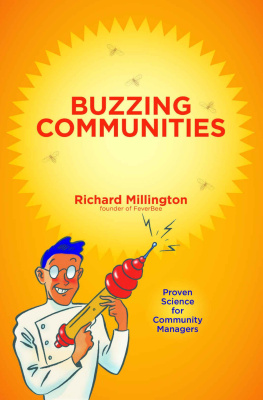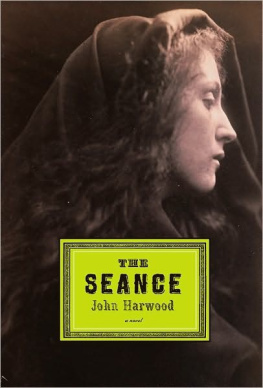2021 by the Charles F. Kettering Foundation
For information about permission to reproduce selections from this book, write to:
This book has been a labor of love. It has been an opportunity to uncover and write about whats possible when people step forward and unleash their own innate capabilities and the potential of their communities.
But I couldnt have done this alone. Indeed, it took a community of people to make this book about community happen.
I want to thank Grady Lenkin and Miranda Klugesherz, two of my former special assistants. Grady helped me develop and launch the idea for this research and develop its framework. Miranda tirelessly managed the community research that forms the basis for the book (and even undertook parts of the research herself); she was incredibly persistent and vigilant in all her efforts.
Serving with Miranda was a team of researchers from The Harwood Institutes Studio on Community; they included Marla Crockett, Rickkay King, Janice Lam, and John Andrew Ouligian. They looked high and low for sources of information and background and history in each of the nine communities that I write about in this book. I am indebted to them for their rigor and perseverance.
Yo-Yo Lin created the wonderful illustrations that you will see following each of the nine community stories. Yo-Yo was a sheer delight to work with. And thanks go to Martha Ransohoff Adler for editing the preliminary report that formed the basis for this longer and expanded book.
Other Harwood Institute staff members also played a key role in helping to bring this book to fruition. Alfred Delena, Max Hoversten, and Colleen Bowman offered important suggestions and edits on various drafts of the book. Colleen managed the design and production of the book; as always, she has done a terrific job.
There are the institute coaches, who walked beside each of these communities, supporting them. I want to thank each of them for their unyielding commitment to the institute and to those they worked with in each community.
Then there are the people in the nine communities who actually produced the changes that you will read about. There are too many to mention here; they know who they are, and they know how much I respect and admire their efforts in stepping forward to strengthen their communities and make hope real for all those who live there.
Finally, I wish to thank four individuals at the Kettering Foundation. Kettering president and CEO David Mathews, as usual, had the foresight to imagine the power of this research and to support the writing of this book. John Dedrick, executive vice president and chief operating officer, lent his support and encouragement as he has done on so many of our previous partnerships with the foundation. I appreciate Alice Diebels comments on the final manuscript. And I would like to extend my deep gratitude to Brad Rourke, program officer, who joined me for long walks and extensive phone conversations, always offering keen insights as he managed this effort on behalf of the foundation.
This story begins where you might expect it to in a local community. More specifically, it was in a local bar.
I was visiting Lebanon, Pennsylvania, to give a keynote speech to community leaders about how they could further catalyze and grow change in their region. The community was experiencing challenges similar to those facing some of the communities you will read about in this book: long-term economic decline, deep racial and ethnic divisions, persistent poverty and unaffordable housing, the exclusion of many residents voices, and civic and political fragmentation.
The community lacked hope.
The night before the speech, my special assistant Grady Lenkin and I went to dinner at a local bar downtown. It was nearly empty. During our meal, I picked up on a conversation that Grady and I had been having for some months: How could we best depict the change and progress that people have unleashed in countless communities where theyve used The Harwood Institutes approach over the past 30 years? How could we capture that change?
The topic had bedeviled me for years. The institute had received funding from many of the largest foundations and nonprofit organizations in the nation. Through these relationships, our work with communities had been evaluated many times by third parties. We ourselves had collected masses of data and stories over the years in different communities and published numerous publicly available reports.
But like many efforts that seek to help communities shape their own futures, it can be difficult to clearly show results, to demonstrate concretely the change that actually happens and how it happens. Such change can take a long time. It can be hard to measure. Many standards for measuring such change miss the actual important progress that is taking place.
At the bar, the conversation turned to the question of how sports agents negotiate on behalf of their clients. In baseball, for instance, agents will pull together numerous binders of data about the players they represent and how those players compare to similar competitors. They will collect statistics about how their players performed in different situations, against different pitchers and teams, and in different stadiums.
That night, I said to Grady, Why dont we create our own binders about our work in communities? And so began this idea. Sitting in the bar over a few beers, we began to furiously scribble out notes on paper napkins about how we could go about putting together such binders. We were fortunate that our waitress repeatedly stopped by to fortify the supply of clean napkins we needed to capture our ever-expanding thinking.
The idea for what is now contained in this book took further shape when Grady and I reached out to a variety of individuals with deep knowledge and experience about how to learn from communities about the changes they undergo and peoples role in it. Then, there was a pivotal conversation I had with David Mathews, president and CEO of the Kettering Foundation. He had been keenly interested in what he called the chain of events that could be revealed about how people in communities come together and make choices in reaching collective decisions and taking action. David and the foundation came to support our work, for which I am deeply grateful.
The effort soon took form and became an initiative of the Studio on Community, an internal entity at the institute that I had created a few years earlier to explore special topics and questions and develop new applied ideas and solutions a kind of Skunk Works endeavor. Each year, new studio associates join us, typically spending 12 months at the institute. They come from all walks of life, from all parts of the country, and from all sorts of professions; what they all hold in common is a deep desire to explore issues of community and public life, and to learn about the institutes approaches so they can take this knowledge back home with them and use it. The studio is one of the most rewarding initiatives Ive launched at the institute.













